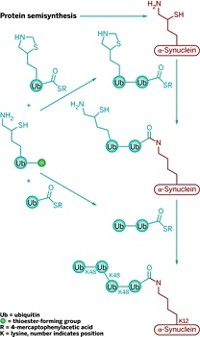Advertisement
Grab your lab coat. Let's get started
Welcome!
Welcome!
Create an account below to get 6 C&EN articles per month, receive newsletters and more - all free.
It seems this is your first time logging in online. Please enter the following information to continue.
As an ACS member you automatically get access to this site. All we need is few more details to create your reading experience.
Not you? Sign in with a different account.
Not you? Sign in with a different account.
ERROR 1
ERROR 1
ERROR 2
ERROR 2
ERROR 2
ERROR 2
ERROR 2
Password and Confirm password must match.
If you have an ACS member number, please enter it here so we can link this account to your membership. (optional)
ERROR 2
ACS values your privacy. By submitting your information, you are gaining access to C&EN and subscribing to our weekly newsletter. We use the information you provide to make your reading experience better, and we will never sell your data to third party members.
Synthesis
RNA Route to Nanoparticles
Evolved RNA sequences cause metal atoms to bond and form uniform crystals
by Stu Borman
April 19, 2004
| A version of this story appeared in
Volume 82, Issue 16
Researchers have used a sequential optimization technique to identify the first RNA sequences that cause the formation of metal-metal bonds, resulting in the synthesis of a novel inorganic material—palladium nanoparticles [Science, published online April 15, http://dx.doi.org/10.1126/science.1095678].

A number of groups have used synthetic polymers, DNA, and even peptide-covered viruses to induce the assembly of inorganic materials and structures, but this is the first such work that’s been carried out with RNA.
In the study, graduate student Lina Gugliotti, associate professor Daniel L. Feldheim, and professor Bruce E. Eaton of the department of chemistry at North Carolina State University used eight cycles of in vitro selection to evolve RNAs in the presence of a palladium(0) complex. The RNAs were modified sequences that included mutant uridine nucleotides to provide additional metal-coordination sites. By selecting for RNAs that formed palladium nanoparticles or bound to them, the researchers were able to identify five families of 87-nucleotide RNA sequences that in catalytic amounts induce the formation of crystalline, hexagonal palladium nanoparticles.
“We now realize that RNA is adept at synthesizing inorganic materials, and this discovery takes the field of RNA-directed evolution in a whole new direction,” comments professor of chemistry and molecular biology Gerald F. Joyce of Scripps Research Institute, La Jolla, Calif.
The method provides uniform and clearly defined nanoparticle shapes “that you wouldn’t be able to achieve by any other known method,” Eaton says. The approximately 20-nm-thick and 1-µm-diameter nanocrystals have potential ferromagnetic and spintronics applications.
The discovery that five families of RNAs catalyze palladium nanoparticle formation suggests that RNAs could be useful in the synthesis of other inorganic materials. The NC State group is currently working to extend the technique to mixed metal and metal oxide materials.





Join the conversation
Contact the reporter
Submit a Letter to the Editor for publication
Engage with us on Twitter